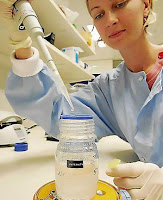Brighter outlook for IVF babies
Photo by www.theage.com.au  IVF pregnancy rates could double and the incidence of serious complications, such as miscarriage and pre-eclampsia, could be halved after a technological breakthrough in fertility research.
IVF pregnancy rates could double and the incidence of serious complications, such as miscarriage and pre-eclampsia, could be halved after a technological breakthrough in fertility research.
Scientists at the University of Adelaide have created a new type of culture which they say will help embryos better survive their five days out of the womb, and help the foetus and placenta develop more normally.
The head of the research team, Claire Roberts, said yesterday the culture, used successfully to grow mice embryos, was "absolutely fantastic" and could change the face of fertility treatments.
"Until now, the culture most commonly used has not been particularly conducive to the survival of embryos, which is one of the main reasons we don't have a very high success rate in IVF," she said.
Women in their 20's have about a 40 per cent chance of falling pregnant through IVF with that dropping to about 15 per cent for women in their late 30's.
But the new culture contains three molecules which exist in the birth tract fluids of all mammals, making it easier for embryos to grow and implant successfully in the uterus.
"It has long been thought that the culture used in IVF alters the way the embryo develops and affects the interaction between the embryo and the mother, which compromises the development of the placenta," Associate Professor Roberts said.
Poor placental growth results in miscarriage, intrauterine growth restriction, haemorrhage and premature births. Women who have undergone IVF are three times more at risk of these complications than women who have conceived naturally.
Human trials are expected to begin within two years and if successful, could help the 15 per cent of couples who are infertile or suffer from recurrent miscarriages.
The new culture could also help researchers achieve the "holy grail" of IVF - a single embryo transfer, which reduces the incidence of multiple pregnancies and maximises the chance of a successful pregnancy.
A fertility expert with IVF Australia, Michael Chapman, said it was still difficult to artificially mimic the human body when creating embryo cultures.
"Mice are not men - or women, so we have to approach this with a fair degree of caution, but if it is proven safe in humans this is a great step forward," Professor Chapman said.
Source: http://www.theage.com.au/news/national/breakthrough-could-double-ivf-successes/2008/04/15/1208025189639.html
Life Begins...
Miscarriage stories of loss, hope & help
http://born2luv.blogspot.com/
Stories of Pregnancy & Birth over 44y
- Daily blog of hope & inspiration!
http://pregnancyover44y.blogspot.com/
4,600 Stories of Pregnancy & Birth over 44y
Daily blog of hope & inspiration!
http://pregnancyover44y.blogspot.com/
Recent Keyword Searches: can women over 50 get pregnant, hair thin progesterone level low can i get pregnant, can a 45 year old woman get pregnant, get pregnant age 40, until what age can ivf be tried, case study high fsh pregnancy, getting pregnant after miscarriage in forties, fertility when the mother is in her 40's, successful pregnancy with one follicle over 40, if i take aspirin before implantation will it help
Category: embryo, embryo transfer, IVF, Miscarriage, research









0 comments